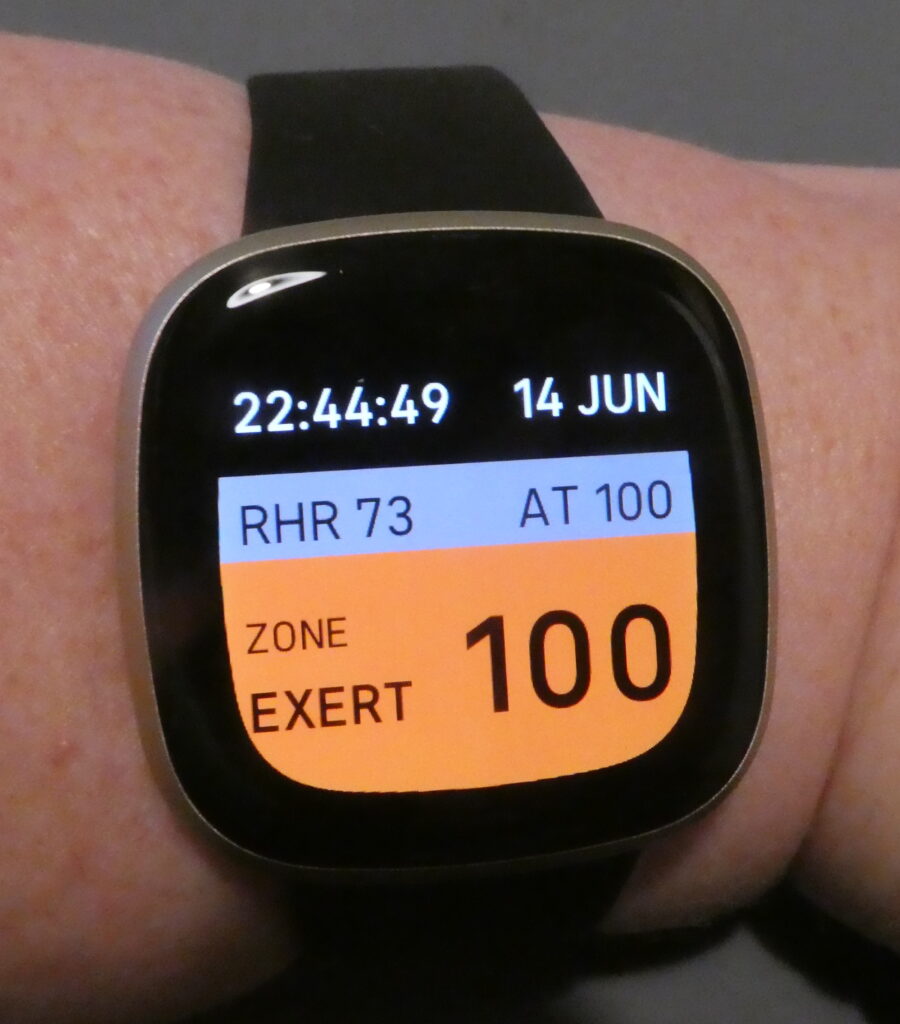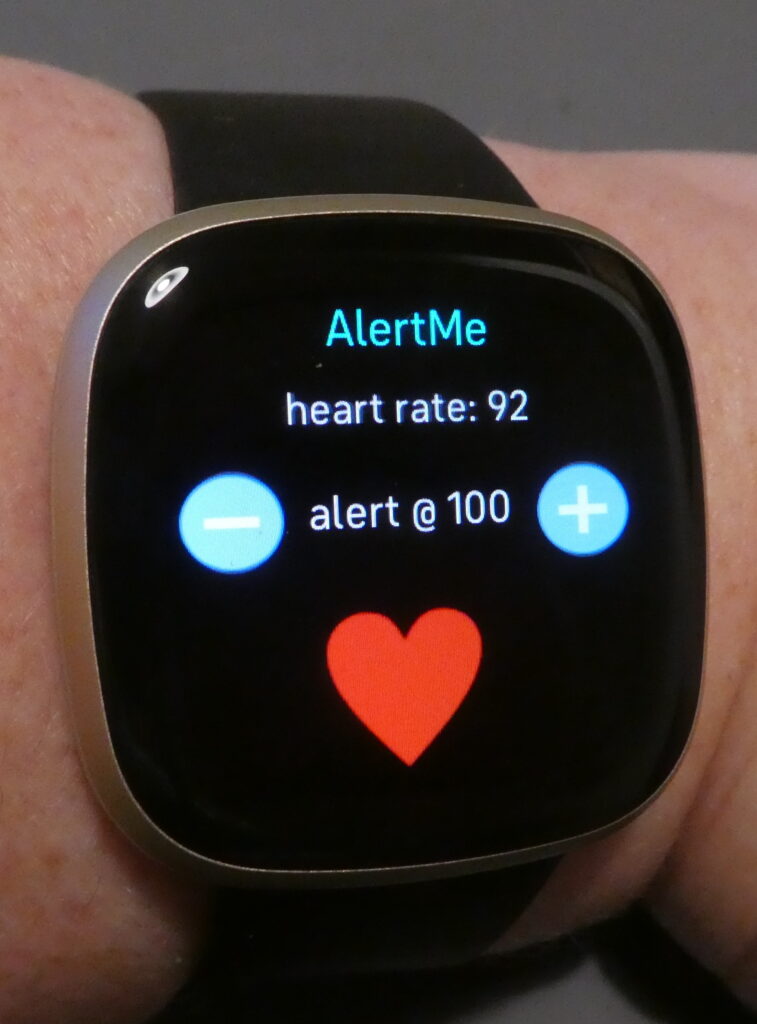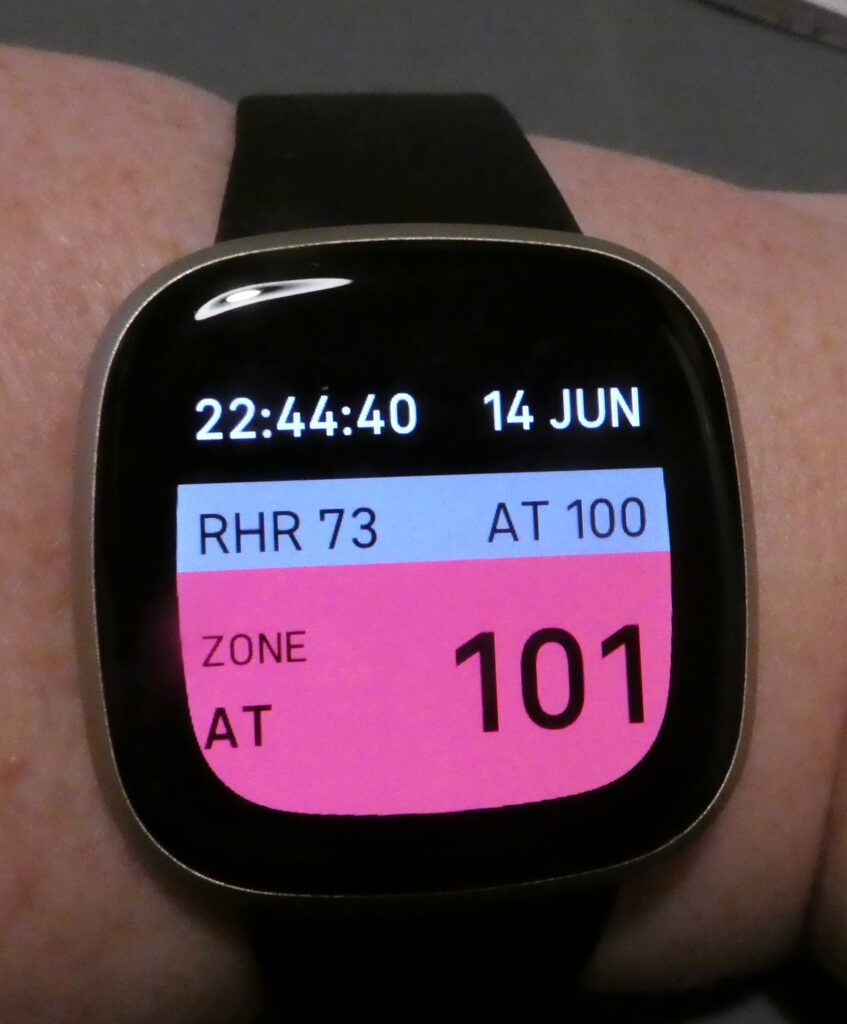A couple of months ago I was asking questions on Mastodon and Twitter for help with finding a heart rate monitor to help me better manage pacing and my MECFS symptoms. The reason for this was that I’d read a couple of interesting articles about people with ME who had used heart rate monitors in this way, and had slowly managed to achieve some improvement in pacing/symptoms and quality of life.

My ME is getting pretty bad. I have many more bad days than good (actually, I don’t have any good days, just some less bad days) and this has been steadily going on a downward trajectory. The only practical thing anyone with ME might be able to currently do to help manage their symptoms, as there are no medications/cures available at this point in time, is pacing. However, I’ve always struggled with pacing, stopping part way through a task is not in my DNA. So I tend to go into to a boom and bust/rolling PEM (post-exertional malaise) cycle.
So it was with great interest I read Hannah’s Story in a Health Rising blogpost in early April, and how she used a heart rate monitor to help her pace more effectively. I followed this up further reading on this topic in an article on the Solve ME website (with the longer version here). I’m not going to try and repeat what these articles said, as it makes more sense to read them than my clumsy interpretation, other than to say that they used a formula, i.e. (220-your age) x 0.6 = heart rate at AT (anaerobic threshold)1, to find out what their anaerobic threshold was, and to stop every time they went over this. As I say, it’s much more involved than this; this is my ‘nutshell’ description. Read the linked to articles to get a clear understanding. Seriously, read them.
For me, my anaerobic threshold is 100bpm (beats per minute).
When it came to finding the right wrist-based heart rate monitor for me2, well, that was less straight-forward. The big issue I came up against was the confusion over what task I needed the device to specifically manage. It seemed that all heart rate monitors/apps that I looked up, said they would vibrate/let you know when you had gone over a specific heart rate. I assumed this meant that every time I went over the specific heart rate I set (for me, 100bpm), the device would vibrate/alert me. But what it actually meant was that if you had been resting for more than 10 minutes and suddenly your heart rate went over the bpm you set, then it would alert you.
Whilst this might sound similar, it’s not. What I needed was the device to alert me if I’d gone over my set heart rate, when I was active. That is, whether brushing my teeth, making breakfast, doing a bit of gardening etc, it would alert me if I went over my set heart rate. Because to help me pace better, I needed the device to alert me so that I would then know I needed to stop and rest. Right now. The former (resting alert) might be what you need if you were specifically wanting to manage your heart’s health, whereas the latter is helping me to manage pacing. In the latter, I’m interested in my bpm because it tells me when I’ve met my anaerobic threshold and should stop, from an ME perspective.

My partner and I looked at a lot of devices and at first, I settled on the Garmin Vivosmart 4. However, this is when I came across the abovementioned problem of when it told me I’d gone over my bpm, i.e. when I was resting, not when I was active. So this one wasn’t for me, but fortunately it was for my partner, so it hasn’t been wasted.
So we did a lot more research, now knowing exactly what I wanted to manage. In the end, the only device that I could find that would do what I wanted was a Fitbit Versa 3, which had two apps that that would do exactly what I wanted. Not a cheap option at £180, but we decided it was worth the investment if it would work.
The two apps that do the task3 are: AlertMe and HRPacing. You can set both to the bpm threshold you want. The former will then keep vibrating until your bpm goes lower than your threshold, the latter send out intermittent softer vibrates until your bpm is lowered. The former is really good if I’m in the garden, as it’s so insistent I just have to stop. Which is EXACTLY what I need. A device basically yelling at me. Lolsob. However, in the house I tend to use the latter as this is enough of a reminder that I notice it. I think this might say something about how single-minded I can be in the garden..?!

I’ve now been using the Fitbit/apps for a few weeks. And the big question, is it working? Well, to be honest, in the aim for me to have lessened symptoms and more energy, that remains to be seen. This isn’t a quick fix. In fact, it could well take a few months before I really notice some obvious improvement (as I said, read those articles). But what it is doing in the short term, is changing my behaviour. I’m resting a lot more, because it turns out, it doesn’t take much for me to go over the 100bpm threshold.
For example: just going to the bathroom – over 100bpm in no time. Brushing teeth – same. When I make my breakfast, I have to do it in three parts. I get out the bowl, utensils, yoghurt, juice, and the alert is vibrating and I have to sit down. I pour my juice and put yoghurt in my bowl. Alert. I sit down again, then put in my museli, seeds and nuts etc and ALERT. At least by now my breakfast is ready… For resting (in this case, sitting down), I usually wait until I get below 90bpm before I get up again.
As you can see, it takes very little to make my bpm reach the threshold. The thing is, and the thing that’s going to take months to change, is that I cannot just keep doing something, get to 100bpm and have a short rest, then keep going, over and over. Because this won’t change very much at all and I’ll still be doing too more than I should if I want to improve. What I need to do, is stay UNDER 100bpm. At all times. Which as you can see, is going to be pretty bloody hard.
If I’m to see any real improvement, I need to be doing less than I’m currently doing. A lot less. Which is distressing, as I feel I do very little as it is. But from reading and learning from the above mentioned articles, there is a chance I can improve, IF I change my behaviour and do less and not go over 100bpm. I think this is going to be the hardest thing I’ve ever done. But a cure for ME is not looking likely, and pacing using a heart rate monitor, just might give me a chance at some improvement. I’m scared of becoming bedbound; I’ll take any chance I can to stop that.
One unexpected bonus of using this method, is the PHYSICAL PROOF that there is something wrong with me. Because, whilst those bpm’s might not look like much as you read this, reaching the 100bpm threshold doing the most basic tasks, is NOT normal. Not normal at all. My partner, who is healthy, can spend 30 minutes running around doing housework and making lunch, and their bpm is only 78. Mine is 100bpm to spend a minute brushing my teeth. The other day, I sat up for lunch with my partner. His heartrate was 64 bpm, even after preparing food and drinks. Mine was 96, after having been lying down in bed, and all I did was come downstairs and sit on a chair. You cannot fake a heart rate. So take that Wessley et al. Using the monitor has given me extra confidence that there is indeed, something very wrong with me/ME.
Anyway, wish me luck!
* * * * *
- (220-your age) x 0.6 = heart rate at AT (anaerobic threshold). Scroll down to the section Measuring Maximum Heart Rate in Hannah’s article.
- I tried looking for a medical type heart rate monitor I could have on my wrist, but could not find anything and just kept getting Fitbit, Strava etc in my searches. It would be good if you could just get a heart rate monitor rather than having to buy a ‘fitness’ device. If anyone knows of one, that does what I describe (whilst I’m active), please leave the information in a comment. Oh, and I also considered a chest strap, like a Polar one, but I as I need something I can wear 24/7, this wouldn’t be comfortable.
- Yes, I have tried using alarms. These can be helpful if I’m gardening and I set my alarm for 5 minutes. But I’ve discovered that even gardening for 5 minutes is sadly too much. I’ve discovered that by using these apps, that I might spend a minute gardening, then a couple of minutes resting, and repeat. Whilst I still end up exhausted, I’m not quite so exhausted, which is a tiny but important improvement, because then the PEM isn’t quite so bad. I think partly because the monitor tells me I’m going over my threshold, it’s making me realise I have to do less and so I reduced how much I was planning on doing. For me, psychologically, the heart rate monitor just works better than an alarm.
See also: Update 1: Using a heart rate monitor to better manage MECFS (including HRV).
I really want to try this, and I already have an Apple watch. Before I go down the app store rabbithole, did you consider the Apple watch in your search?
I briefly considered the Apple Watch, but as everything I have is PC/Android, it wasn’t a practical choice. So I don’t know if there is a specific Apple app that does what I describe above (active). If you find one, please let us know!
Thank you so much for this information. I currently have a inspire 3 fitbit but it’s like the experience you had with your first purchase. So I’m looking into purchasing a versa. I can’t seem to find the apps you mention though is it just in the play store? Or somewhere else. Thanks for your help!
The two apps that work on the Versa 3 are:
https://gallery.fitbit.com/details/240bd0c9-5c5a-4dc3-9a1b-b738c26c5143
and https://gallery.fitbit.com/details/c8efa7e2-2881-4877-a962-cfc58e077932
You get them via Fitbit, not the play store. You should be able to find them on your phone via the Fitbit app.
Someone on metafilter claims that Heartwatch can do this, but I spent an afternoon trying and couldn’t get it to give me audible or vibration alerts. Plus it didn’t seem to update its background pulse reading more than once every 10 minutes. I’m going to get in touch with the developers and see if there’s something I’m missing.
It’s definitely worth checking with the developers. It would be great if there was an Apple app that did this. Let me know how you get on.
Thank you! This is exactly the research I’ve been doing. You saved me a lot of pain. I hope your HRM journey is going well.
I have been scouring the interwebs for over an hour looking for exactly what you discuss here – a wearable device that alerts me any time my HR goes over my AT (107, confirmed by CPET a few weeks ago), not just after 10 minutes of rest. Thank you so much for this!!
This is exactly the information I needed, thank you so much for posting this! I was getting so frustrated trying to find a device that would tell me when I go over a certain threshold, and not just while resting!
THANK YOU! I too haven spending hours over a few days – although I start to crash so have to stop – trying to find the right fitness watch for this. Actually, a Walmart rep in electronics said FitBit Versa 3 would do it, but of course I had my doubts. So I have still been researching. Now I don’t have to look anymore! You have confirmed and that is SOOOOOO very helpful. I have been in push-crash for over 15 years so I definitely need something tugging at me to take it down a notch. Feeling very hopeful. Really, thank you for taking the time and precious energy to write this!
Thank you so much for telling about this! Just what i was looking for.
Thanks Gwenfar, again this is the exact info I needed! Can I ask how you have found this method of pacing has helped with your me/cfs please? 🙏 All the best, Dom Ranson
Glad you found it useful. The latest post is: Update 2: Using a heart rate monitor to better manage MECFS (finding my baseline, halting decline)
Hi, thank you so much for this super helpful article.
Wondering if anyone can help me with a silly question. I bought a Versa 3 after reading this and downloaded HRPacing but I can’t figure out how to get it to alert me when I’m over my AT. I keep it open all the time but my watch doesn’t vibrate when I’m over so I have to keep checking my watch. I’ve fiddled with the settings, no luck but i’m obviously missing something. Could anyone tell me how to set up the alert function for it? TIA!
Glad the post was helpful.
For the HRPacing app, weirdly, you have to change it via the Fitbit app on your phone. To do this:
1. click on your icon to go to settings.
2. Scroll down and click ‘Connected Apps’, then ‘compatible apps.
3. Do a search for HRPacing and click on ‘open app’.
4. Go to settings and change the last item ‘Anaerobic Threshold Tolerance’ moving the big circle to either .5, .55 or .6. This will then update it on your watch.
It’s really quite complicated and maybe there is an easier way, but this is the only way I know how.
The Alert Me app is easier as you can do it on your watch, but once you set it on HRPacing, you shouldn’t need to change it again.
I hope this helps.
Thanks so very much for figuring this all out. It’s now July 2023, and as I shop around, I see the Fitbit Versa 4. Some stores have discontinued the Versa 3, but it is available on Amazon. Hmmm, I think I will take a chance on the 4, at a local store, so a return will be easier. Will update this with the “results”!
Alison
Hi Alison I’m looking at doing the same are the apps compatible with Versa 4? as it is not listed in the fitbit app.
There’s a relatively new app called Visible which is designed to help monitor heart rate and symptoms in ME/CFS. They are working towards a wearable heart rate monitor and I’m fortunate to be part of the beta testing group. If you’re interested and willing to wait a little while I can recommend the app; I’m just working out adapting my lifestyle to the alerts which is quite a challenge. Thank you for your encouragement
Yes, I’ve recently just started using this to see how it goes. I’m thinking of trying the Polar wearable that goes with the app and see if that does the same thing as the apps, i.e. tell me right when I’m going over my Anaerobic Threshold. Once I’ve tried it for a while, I’ll do an updated post.
BTW: people can find the Visible app here: https://www.makevisible.com/
Thank you so much for this information. I currently have a inspire 3 fitbit but it’s like the experience you had with your first purchase. So I’m looking into purchasing a versa. I can’t seem to find the apps you mention though is it just in the play store? Or somewhere else. Thanks for your help!